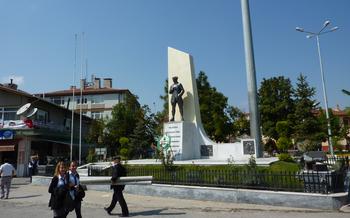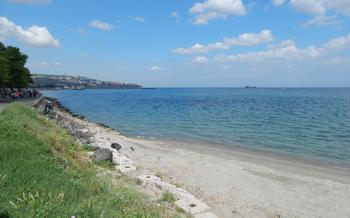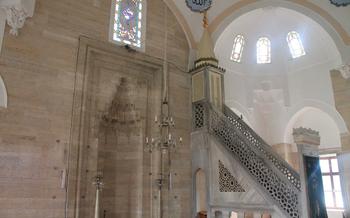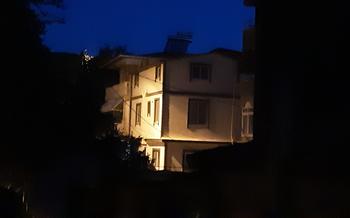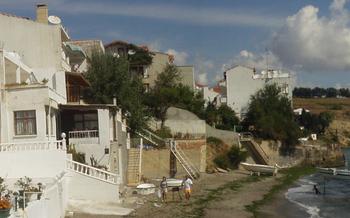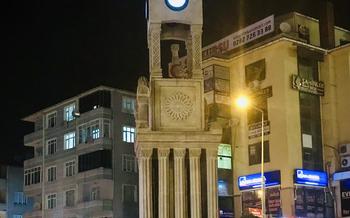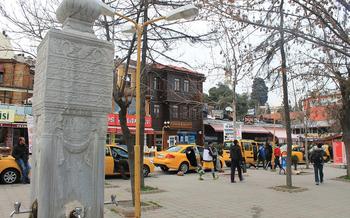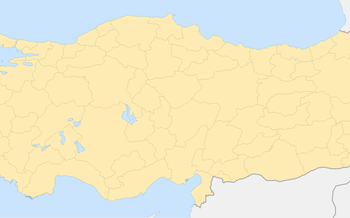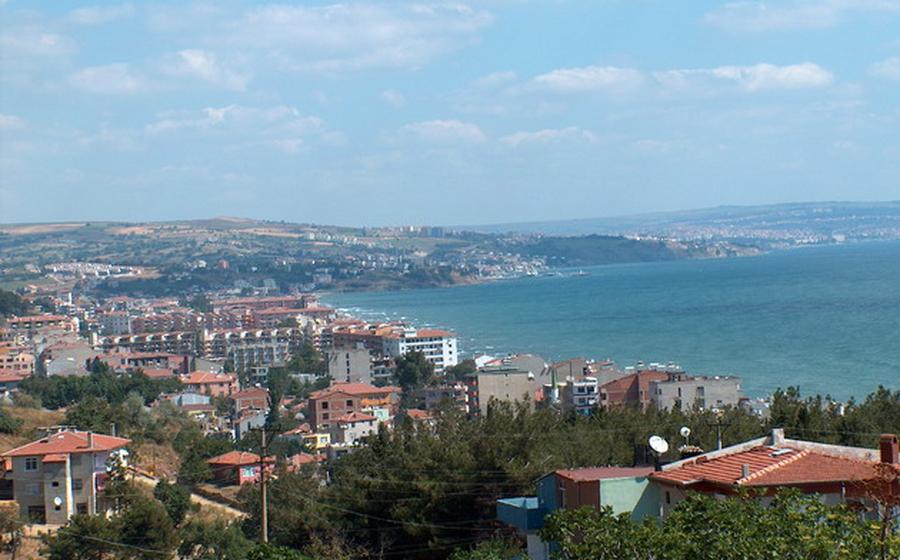
Namık Kemal House
- The Namık Kemal House: A Literary Landmark
- Historical Context: Namık Kemal's Life and Times
- Exploring the Namık Kemal House Museum
- Literary Significance of Namık Kemal's Works
- Namık Kemal's Political Activism and Legacy
- Cultural Importance of the Namık Kemal House
- Getting to the Namık Kemal House
- Hours of Operation and Admission Fees
- Guided Tours and Educational Programs
- Exploring Tekirdağ Beyond the Namık Kemal House
- Namık Kemal's Impact on Modern Turkey
- The House as a Center for Literary Research
- Preservation and Restoration Efforts
- Events and Exhibitions at the Namık Kemal House
- Insider Tip: Hidden Gems of the Namık Kemal House
The Namık Kemal House: A Literary Landmark
Located in the heart of Tekirdağ, Turkey, the Namık Kemal House stands as a testament to the life and legacy of renowned Turkish poet and playwright Namık Kemal. Built in the mid-19th century, this historic house is a treasure trove of literary history, preserving the memory of one of Turkey's most influential figures.
With its unique architectural style and distinctive features, the Namık Kemal House is a sight to behold. Constructed in a traditional Ottoman style, the house boasts intricate woodwork, decorative tilework, and a spacious courtyard that invites visitors to step back in time.
As a museum, the Namık Kemal House plays a crucial role in preserving and promoting Turkish literature. It houses a collection of Namık Kemal's personal belongings, manuscripts, and other artifacts, offering visitors a glimpse into his creative process and the world he inhabited. Interactive exhibits and multimedia presentations bring his life and work to life, making the museum an engaging and educational experience for visitors of all ages.
Historical Context: Namık Kemal's Life and Times
Namık Kemal's life was deeply intertwined with the tumultuous events that shaped the Ottoman Empire during the 19th century. Born in 1840, he witnessed the decline of the empire and the rise of new political and social forces.
Early Life and Education: Namık Kemal's early life was marked by a thirst for knowledge and a passion for literature. He received a traditional education, studying Islamic sciences and classical Ottoman literature. However, his curious mind led him to explore Western literature and philosophy, which would greatly influence his later writings.
Political and Social Climate: The Ottoman Empire underwent significant changes during Namık Kemal's lifetime. The Tanzimat reforms, initiated in 1839, aimed to modernize the empire and introduce Western-style institutions. These reforms created a vibrant intellectual and cultural atmosphere, but also sparked debates about the empire's future and its relationship with the West.
Tanzimat's Influence: Namık Kemal was deeply engaged with the Tanzimat movement. He saw it as an opportunity to revitalize the Ottoman Empire and promote progress and enlightenment. His writings reflected the spirit of the times, advocating for constitutionalism, freedom of speech, and social justice.
Activism and Exile: Namık Kemal's political activism drew the ire of the Ottoman authorities. His plays and poems, which often criticized the government and called for reforms, led to his arrest and exile. He spent several years in exile in Europe, where he continued to write and advocate for his ideals.
Namık Kemal's experiences and observations during this period shaped his worldview and contributed to his enduring legacy as a symbol of resistance against oppression and a champion of Turkish nationalism. His writings, inspired by his deep love for his country and his belief in the power of literature, continue to resonate with readers and inspire generations of Turks.
Exploring the Namık Kemal House Museum
The Namık Kemal House Museum offers a captivating journey into the life and work of the renowned Turkish poet and playwright. Visitors are welcomed into a meticulously preserved world that showcases Namık Kemal's personal belongings, precious manuscripts, and rare artifacts. The museum's layout is designed to provide a comprehensive narrative of his life, starting from his early years in Tekirdağ to his rise as a prominent figure in Turkish literature.
Interactive exhibits and multimedia presentations bring Namık Kemal's life and work to life. Visitors can immerse themselves in his literary world through audiovisual displays, interactive touchscreens, and engaging storytelling techniques. Guided tours are available in multiple languages, offering insightful commentary and anecdotes that deepen the understanding of Namık Kemal's contributions to Turkish literature and society.
Educational programs and workshops are organized regularly at the museum, catering to students, scholars, and literature enthusiasts. These programs delve into specific aspects of Namık Kemal's writings, explore the historical context of his era, and encourage critical analysis of his works. The museum also hosts literary events, readings, and performances that celebrate Namık Kemal's legacy and promote Turkish literature.
Literary Significance of Namık Kemal's Works
A Luminary of Turkish Literature: Namık Kemal's Literary Contributions
Namık Kemal's body of work is a testament to his literary prowess and his profound impact on Turkish literature. His plays, poems, and novels explore a range of themes and motifs that resonate with readers to this day. Patriotism, a burning love for his homeland, is a recurring theme in his writings. Through his characters and narratives, Namık Kemal instills a sense of national pride and unity among his readers.
Social justice is another prominent theme in Namık Kemal's works. He passionately advocates for the rights of the oppressed and marginalized, using his pen as a weapon against tyranny and injustice. His works champion the cause of the downtrodden, giving voice to their struggles and aspirations.
Individual freedom is a third key theme that runs through Namık Kemal's writings. He believed in the inherent rights and liberties of every individual, regardless of their social status or background. His works celebrate the indomitable spirit of those who dare to break free from the chains of oppression and live their lives with dignity and purpose.
Namık Kemal's literary works not only captivated his contemporaries but also left an enduring legacy on Turkish literature. His plays, particularly, revolutionized Turkish theater, introducing modern dramatic techniques and themes that paved the way for the development of a vibrant theater culture in Turkey. His novels, too, broke new ground, introducing a new genre to Turkish literature and inspiring a generation of writers to explore the possibilities of prose fiction.
Overall, Namık Kemal's literary contributions are immeasurable. He was a pioneer of modern Turkish drama, a leading figure in the Tanzimat movement, and an ardent advocate for social justice and individual freedom. His works continue to be read, studied, and celebrated in Turkey and beyond, solidifying his status as one of the most influential figures in Turkish literature.
Namık Kemal's Political Activism and Legacy
A tireless advocate for constitutionalism, freedom of speech, and other liberal ideals, Namık Kemal actively engaged in political activism throughout his life. As a member of the Young Ottomans movement, he played a crucial role in promoting progressive ideas and challenging the authoritarian rule of the Ottoman Empire. His writings often addressed social and political issues, criticizing corruption, injustice, and oppression.
Kemal's activism led to his exile and imprisonment on several occasions. Undeterred by these hardships, he continued to write and advocate for his beliefs, even from behind bars. His unwavering commitment to freedom of expression and his willingness to challenge the status quo earned him the respect and admiration of many.
Namık Kemal's legacy as a symbol of resistance against oppression and a champion of Turkish nationalism endures to this day. His writings continue to inspire and influence generations of Turks, reminding them of the importance of individual liberty, social justice, and national pride. His political activism paved the way for the eventual establishment of a constitutional monarchy in the Ottoman Empire and laid the foundation for the development of modern Turkish democracy.
Cultural Importance of the Namık Kemal House
The Namık Kemal House holds immense cultural significance as a symbol of Turkish cultural heritage. It serves as a testament to the life and achievements of Namık Kemal, a towering figure in Turkish literature and a pioneer of modern Turkish theater. The house's preservation and transformation into a museum have played a pivotal role in promoting awareness and appreciation of Namık Kemal's work and legacy. Through its exhibits, interactive displays, and educational programs, the museum immerses visitors in the world of this literary giant, shedding light on his contributions to Turkish literature, society, and politics.
The museum's existence contributes to the preservation and revitalization of Turkish literature and history. By showcasing Namık Kemal's personal belongings, manuscripts, and other artifacts, the house provides tangible links to his life and work. Interactive exhibits and multimedia presentations bring his stories and characters to life, engaging visitors in a dynamic and immersive experience. The museum also organizes literary events, workshops, and conferences, creating a platform for scholars, students, and enthusiasts to delve deeper into Namık Kemal's works and their impact on Turkish culture.
As a popular tourist destination, the Namık Kemal House attracts visitors from across Turkey and beyond. It is a must-visit site for literature enthusiasts, history buffs, and anyone interested in exploring the rich cultural heritage of Turkey. The house stands as a testament to the enduring power of literature and its ability to inspire, educate, and shape societies. Its cultural significance extends far beyond its walls, contributing to the preservation and promotion of Turkish literature and history for generations to come.
Getting to the Namık Kemal House
Located in the heart of Tekirdağ, the Namık Kemal House is easily accessible by public transportation. The Tekirdağ Bus Terminal offers frequent services to the city center, where visitors can transfer to local buses or taxis to reach the museum. Alternatively, visitors can opt for a scenic walk from the bus terminal, which takes approximately 20 minutes. The house is situated on Namık Kemal Street, a charming pedestrianized street lined with historical buildings and shops. Visitors traveling by car can find ample parking spaces in the vicinity of the museum.
Hours of Operation and Admission Fees
The Namık Kemal House is open to visitors every day of the week, except for Mondays. Its doors are open from 9:00 AM to 5:00 PM, allowing ample time for exploration and learning. Visitors are advised to plan their visit accordingly to make the most of their time.
Admission to the museum is quite affordable, providing access to a wealth of knowledge and history. The entrance fee for adults is 10 Turkish Lira, while students and children can enjoy a discounted rate of 5 Turkish Lira. It's recommended to carry cash for admission, as card payments may not be accepted.
Advance booking or reservations are not necessary for individual visitors. However, groups or educational institutions planning a visit are encouraged to contact the museum in advance to arrange for a guided tour and ensure a smooth experience.
Guided Tours and Educational Programs
The Namık Kemal House offers guided tours in various languages to enhance visitors' understanding of Namık Kemal's life and work. These tours provide in-depth insights into the exhibits, historical context, and literary significance of the house. Visitors can choose from a range of tour options, including standard group tours, private guided tours, and thematic tours focusing on specific aspects of Namık Kemal's life and activism.
The museum also organizes educational programs and workshops throughout the year to engage students, researchers, and the general public. These programs cover topics such as Turkish literature, history, and cultural heritage. Workshops may include interactive activities, lectures by experts, and hands-on experiences related to Namık Kemal's writings and the Ottoman era.
To book a guided tour or inquire about educational programs, visitors can contact the museum's administration office in advance. The museum staff is available to assist with reservations, provide additional information, and tailor tours to meet specific interests or requirements. Group tours and customized educational experiences can be arranged upon request.
Whether you are a student, a researcher, or simply a literature enthusiast, the Namık Kemal House offers a wealth of opportunities to explore the life and legacy of this renowned Turkish poet and playwright. Through guided tours and educational programs, visitors can gain a deeper understanding of Namık Kemal's contributions to Turkish literature and his enduring impact on Turkish society.
Exploring Tekirdağ Beyond the Namık Kemal House
A visit to the Namık Kemal House can be perfectly complemented by exploring the many other attractions that Tekirdağ has to offer. History enthusiasts can delve into the rich past of the region at the Tekirdağ Museum, home to a collection of artifacts and exhibits that tell the story of Tekirdağ from ancient times to the present day. For those seeking natural wonders, a trip to the Tekirdağ Natural History Museum offers a fascinating glimpse into the region's diverse flora and fauna.
Nature enthusiasts will find solace in the picturesque surroundings of Tekirdağ, with its stunning beaches, lush forests, and rolling hills. Visitors can embark on scenic hikes through the Tekirdağ Mountains, cycle along the picturesque coastlines, or simply relax and soak up the sun on the pristine beaches.
Tekirdağ is also renowned for its vibrant culinary scene. From traditional Turkish fare to international cuisine, there's something to satisfy every palate. Be sure to sample some of the local specialties, such as Tekirdağ köftesi (meatballs), Tekirdağ pilavı (rice dish), and Tekirdağ üzümü (grapes).
To make the most of your visit, consider planning a day trip or extending your stay in Tekirdağ. The city offers a range of accommodation options to suit every budget, from cozy guesthouses to luxurious hotels. Whether you're a history buff, a nature lover, or a foodie, Tekirdağ has something to offer everyone.
Namık Kemal's Impact on Modern Turkey
Namık Kemal's influence extends far beyond the literary realm, shaping the very fabric of modern Turkish society. He played a pivotal role in fostering Turkish national identity and promoting cultural unity during a time of significant transformation and uncertainty. His writings and activism ignited a sense of patriotism and a desire for independence among the Turkish people. His ideas and ideals resonated deeply with the masses, inspiring them to embrace their cultural heritage and strive for a more just and equitable society.
Kemal's legacy continues to shape contemporary Turkish politics and culture. His emphasis on individual rights, freedom of expression, and social justice remains relevant in addressing contemporary social and political issues. His works serve as a reminder of the importance of preserving cultural heritage and promoting national unity in the face of challenges. Namık Kemal's impact on modern Turkey is undeniable, cementing his status as a towering figure in Turkish history and literature.
The House as a Center for Literary Research
The Namık Kemal House is not merely a museum showcasing the life and work of the renowned poet and playwright. It also serves as a vibrant center for literary research and scholarship. The house features a well-equipped research library that houses a vast collection of books, manuscripts, and documents related to Namık Kemal and his era. Scholars and researchers can access these resources to conduct in-depth studies on Namık Kemal's life, works, and the broader context of Ottoman and Turkish literature.
The museum collaborates with universities, research institutions, and cultural organizations to promote literary research and scholarship. It hosts conferences, seminars, and workshops on various aspects of Turkish literature and history, bringing together experts and enthusiasts from around the world. These events provide a platform for scholarly exchange, intellectual discourse, and the dissemination of new knowledge.
The Namık Kemal House also offers opportunities for researchers to conduct residencies and fellowships at the museum. Resident scholars can immerse themselves in the historical atmosphere of the house and have dedicated access to the research facilities and resources. They can engage in independent research projects, collaborate with other scholars, and contribute to the advancement of knowledge in the field of Turkish literature.
Preservation and Restoration Efforts
The Namık Kemal House, a testament to Turkish literary heritage, has undergone meticulous preservation and restoration efforts to maintain its historical integrity. These endeavors have been guided by a deep respect for the house's significance and the need to safeguard its unique architectural features.
Challenges emerged during the restoration process, as the house had experienced wear and tear over time. However, through careful planning and collaboration with experts in conservation, the original structure and details of the house have been meticulously preserved.
Government agencies, cultural organizations, and private donors have played a crucial role in supporting these preservation efforts. Their contributions have enabled the restoration of the house to its former glory, ensuring that future generations can continue to appreciate its historical and literary value.
The success of the preservation and restoration work at the Namık Kemal House serves as a model for safeguarding Turkey's rich cultural heritage. It demonstrates the importance of collaboration, expertise, and a shared commitment to protecting the nation's historical treasures.
Events and Exhibitions at the Namık Kemal House
The Namık Kemal House is not just a static museum; it's a vibrant cultural hub that hosts a variety of events and exhibitions throughout the year. These events are designed to engage visitors with Namık Kemal's work, Turkish culture, and contemporary social issues.
Temporary exhibitions showcase the works of emerging and established artists, shedding light on diverse perspectives and artistic expressions. These exhibitions often explore themes related to Namık Kemal's life and writings, such as patriotism, social justice, and individual freedom.
Cultural events, such as poetry readings, theater performances, and musical concerts, are regularly held at the museum. These events bring Namık Kemal's works to life and provide a platform for contemporary artists to share their interpretations of his legacy.
The museum also hosts educational programs and workshops for students, researchers, and the general public. These programs offer in-depth insights into Namık Kemal's life, works, and the historical context of his time.
To stay updated on the latest events and exhibitions at the Namık Kemal House, visitors can check the museum's official website or social media pages. By participating in these events, visitors can gain a deeper understanding of Namık Kemal's impact on Turkish literature and society, while also experiencing the vibrant cultural scene of Tekirdağ.
Insider Tip: Hidden Gems of the Namık Kemal House
Beyond the main exhibits and well-known artifacts, the Namık Kemal House holds hidden gems that offer unique perspectives and memorable experiences. One such gem is the secluded garden at the back of the house. This tranquil oasis, often overlooked by visitors, provides a serene retreat where you can relax and soak in the atmosphere of Namık Kemal's time. Take a moment to sit on one of the benches, surrounded by lush greenery and the gentle sound of birdsong, and let your imagination transport you back to the era of the great poet and playwright.
Another hidden gem is the small study on the second floor, where Namık Kemal spent countless hours writing and contemplating. Here, you can almost feel his presence as you gaze at his writing desk and the books that lined his shelves. Imagine him pacing back and forth, lost in thought, as he crafted his powerful works that would shape the course of Turkish literature.
If you're lucky, you might stumble upon a hidden door leading to a secret passageway that connects the house to the nearby mosque. This passageway was reportedly used by Namık Kemal to discreetly attend prayers without being seen by the authorities, who were often suspicious of his political activities. Discovering this secret passageway is like uncovering a piece of history, adding an extra layer of intrigue to your visit.
Finally, don't miss the opportunity to explore the surrounding neighborhood, where you can find charming cafes, independent bookstores, and traditional Turkish shops. Take a leisurely stroll and soak in the local atmosphere, imagining what it was like when Namık Kemal himself walked these streets, drawing inspiration from the sights and sounds around him.
